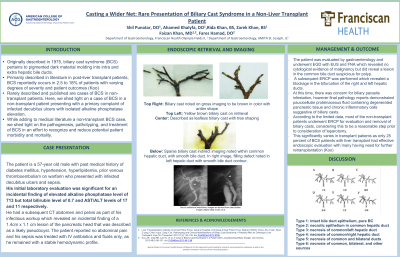Back

Poster Session B - Monday Morning
Category: Biliary/Pancreas
B0068 - Casting a Wider Net: Rare Presentation of Biliary Cast Syndrome in a Non-Liver Transplant Patient
Monday, October 24, 2022
10:00 AM – 12:00 PM ET
Location: Crown Ballroom


Shil Punatar, DO
Franciscan Health Olympia Fields
Schaumburg, IL
Presenting Author(s)
Shil Punatar, DO1, Ahamed Khalyfa, DO2, Faizan Khan, MD2, Rida Khan, BS3, Zarek Khan, BS4, Fares Hamad, DO5
1Franciscan Health Olympia Fields, Olympia Fields, IL; 2Franciscan Health, Olympia Fields, IL; 3Michigan State University College of Human Medicine, Chicago, IL; 4St. Matthews University of Medicine, Chicago, IL; 5St. Joseph Amita Health, Joliet, IL
Introduction: Biliary cast syndrome (BCS) has been described in literature as the presence of casts within the confines of the biliary system, in extra or intrahepatic regions. A rare presentation, most cases of BCS have been described in patients who have undergone liver transplantation. The exact mechanism of BCS has yet to be clearly extrapolated, but point to inflammation of the bile duct or ischemic injury of biliary endothelium. Here, we describe the incidental finding of BCS mimicking biliary parasitosis in a patient without history of liver transplantation and subsequent retrieval and pathological analysis.
Case Description/Methods: The patient is a 57-year old male with past medical history of diabetes mellitus and prior venous thromboembolism on warfarin who presented with infected decubitus ulcers. His initial laboratory evaluation was significant for an incidental finding of elevated alkaline phosphatase level of 713 but total bilirubin level of 0.7 and AST/ALT levels of 17 and 11 respectively. He had a subsequent CT abdomen and pelvis as part of his workup which revealed an incidental finding of a 1.4cm x 1.1 cm lesion of the pancreatic head that was described as a likely pseudocyst. The patient was evaluated by gastroenterology and underwent EGD with EUS and FNA which revealed no cytological evidence of malignancy but did reveal a lesion in the common bile duct suspicious for polyp. A subsequent ERCP was performed which revealed a blockage in the bifurcation of the right and left hepatic ducts. There was initial concern for biliary parasite infestation, however final pathology reports demonstrated paucicellular proteinaceous fluid containing degenerated pancreatic tissue and chronic inflammatory cells suggestive of biliary casts.
Discussion: As cases of BCS are rare in transplant patients and exceedingly rare in those without transplant, the discussion focuses on the composition of biliary casts, potential causes of development and consensus means for treatment. Based on our knowledge and existing literature, only six commonly cited cases exist of BCS in non-transplant settings. No consensus currently exists on the management and evaluation of BCS, with most non-transplant patients undergoing ERCP for evaluation and removal of biliary casts. With this case, we contribute to the small body of literature on non-liver transplant regarding the clinical presentation of patients with BCS, the laboratories associated with BCS, as well as treatment options.
Disclosures:
Shil Punatar, DO1, Ahamed Khalyfa, DO2, Faizan Khan, MD2, Rida Khan, BS3, Zarek Khan, BS4, Fares Hamad, DO5. B0068 - Casting a Wider Net: Rare Presentation of Biliary Cast Syndrome in a Non-Liver Transplant Patient, ACG 2022 Annual Scientific Meeting Abstracts. Charlotte, NC: American College of Gastroenterology.
1Franciscan Health Olympia Fields, Olympia Fields, IL; 2Franciscan Health, Olympia Fields, IL; 3Michigan State University College of Human Medicine, Chicago, IL; 4St. Matthews University of Medicine, Chicago, IL; 5St. Joseph Amita Health, Joliet, IL
Introduction: Biliary cast syndrome (BCS) has been described in literature as the presence of casts within the confines of the biliary system, in extra or intrahepatic regions. A rare presentation, most cases of BCS have been described in patients who have undergone liver transplantation. The exact mechanism of BCS has yet to be clearly extrapolated, but point to inflammation of the bile duct or ischemic injury of biliary endothelium. Here, we describe the incidental finding of BCS mimicking biliary parasitosis in a patient without history of liver transplantation and subsequent retrieval and pathological analysis.
Case Description/Methods: The patient is a 57-year old male with past medical history of diabetes mellitus and prior venous thromboembolism on warfarin who presented with infected decubitus ulcers. His initial laboratory evaluation was significant for an incidental finding of elevated alkaline phosphatase level of 713 but total bilirubin level of 0.7 and AST/ALT levels of 17 and 11 respectively. He had a subsequent CT abdomen and pelvis as part of his workup which revealed an incidental finding of a 1.4cm x 1.1 cm lesion of the pancreatic head that was described as a likely pseudocyst. The patient was evaluated by gastroenterology and underwent EGD with EUS and FNA which revealed no cytological evidence of malignancy but did reveal a lesion in the common bile duct suspicious for polyp. A subsequent ERCP was performed which revealed a blockage in the bifurcation of the right and left hepatic ducts. There was initial concern for biliary parasite infestation, however final pathology reports demonstrated paucicellular proteinaceous fluid containing degenerated pancreatic tissue and chronic inflammatory cells suggestive of biliary casts.
Discussion: As cases of BCS are rare in transplant patients and exceedingly rare in those without transplant, the discussion focuses on the composition of biliary casts, potential causes of development and consensus means for treatment. Based on our knowledge and existing literature, only six commonly cited cases exist of BCS in non-transplant settings. No consensus currently exists on the management and evaluation of BCS, with most non-transplant patients undergoing ERCP for evaluation and removal of biliary casts. With this case, we contribute to the small body of literature on non-liver transplant regarding the clinical presentation of patients with BCS, the laboratories associated with BCS, as well as treatment options.
Disclosures:
Shil Punatar indicated no relevant financial relationships.
Ahamed Khalyfa indicated no relevant financial relationships.
Faizan Khan indicated no relevant financial relationships.
Rida Khan indicated no relevant financial relationships.
Zarek Khan indicated no relevant financial relationships.
Fares Hamad indicated no relevant financial relationships.
Shil Punatar, DO1, Ahamed Khalyfa, DO2, Faizan Khan, MD2, Rida Khan, BS3, Zarek Khan, BS4, Fares Hamad, DO5. B0068 - Casting a Wider Net: Rare Presentation of Biliary Cast Syndrome in a Non-Liver Transplant Patient, ACG 2022 Annual Scientific Meeting Abstracts. Charlotte, NC: American College of Gastroenterology.
